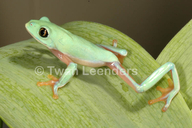|
Agalychnis annae (Duellman, 1963)
Blue-sided Tree Frog, Rana de Cafetal | family: Hylidae subfamily: Phyllomedusinae genus: Agalychnis |
 © 2006 Twan Leenders (1 of 27) |
|
|
|
Description This frog is quite colorful. In contrast to the uniform green upper surfaces, the proximal dorsal portion of the upper arm is pink to lavender and the distal portion is blue. The flanks and anterior and posterior thigh surfaces are blue. The upper surface of the hands and feet are green, orange, and blue. There are vivid creamy yellow stripes along the ventrolateral margin of the forearm, tarsus and foot. The venter is creamy yellow to orange. This species is able to undergo metachrosis (color change), and the colors darken at night to a darker green and bluish purple. Metamorphs lack blue coloring and turn reddish brown at night and in preservative (Savage 2002). Larvae are moderately sized and have a total length of 33 mm at stage 31. The eyes are dorsolateral and directed laterally and the nostrils are dorsolateral and directed anterolaterally. The tail is moderate, caudal fins are high and the tail tips are short. The oral disc is small and entire, with large, serrated beaks and 2/3 rows of denticles. The mouth is located anteroventrally and directed anteriorly. Papillae border the mouth in two rows and laterally scattered small papillae lie medially to the fringing row. The spiracle is ventral and sinistral to the midline (Duellman 2001). Tadpoles have a heavily pigmented snout, top of head, and body, appearing grayish brown. The sides of the body are bluish gray, and the venter is light blue-gray with a silvery cast. The larval caudal musculature is a light gray brown. The caudal fins are clear with brown dashes on the proximal edges of the anterior half of the dorsal and ventral fins. During development, the pigmentation increases on the dorsal surface of the body and the caudal musculature, while the pigment in the caudal fins decreases. The iris is yellow (Duellman 2001). Distribution and Habitat Country distribution from AmphibiaWeb's database: Costa Rica
Life History, Abundance, Activity, and Special Behaviors
The breeding season is during the rainy season from May to November. Calling males usually are found above ponds in hanging vegetation. Amplexus takes place 3 to 10 m above the ground. The female will carry the male, climbing down to a water source and then returning to vegetation to find a deposition surface for the eggs. Eggs are oviposited from 350 mm to 3 m above water (Duellman 2001) on leaves, branches or vines, contained within a clear jelly (Savage 2002). The eggs are pale green and are about 4 mm in diameter, including the envelope. Egg will become creamy tan with development. There are 47 to 162 eggs per clutch. Eggs hatch after about six days from oviposition. Tadpoles vigorously wriggle to free themselves from the egg capsule and will slide or drop, or be washed from vegetation into water. Laboratory raised tadpoles metamorphosed in 247 days, but development is probably more rapid under natural conditions (Duellman 2001). Trends and Threats Megaselia scalaris fly larvae kill and feed on the healthy eggs of A. annae. Although this occurs infrequently overall, one population can be significantly diminished by M. scalaris predation. In August of 1980, M. scalaris larvae were found in 7 of 127 studied clutches in a private botanical garden near San Jose, Costa Rica. In a further experiment sparked by this study, .6-1.5 A. annae eggs per larva were destroyed by M. scalaris predation. There was also significantly reduced viability in M. scalaris-infested clutches of A. annae (28.3-57.2% hatching in the experimental group versus 98.3% hatching in the control group), possibly the result of fungal infestation, the secretion of digestive enzymes by M. scalaris larvae, or even the actions of other micro-organisms (Villa and Townsend 1983). Defenders of Wildlife and SSN have recently recommended that the United States advocate for inclusion of Agalychnis annae in Appendix II of CITES (Convention on International Trade in Endangered Species), which would recommend controls on commercial trade in this species. Agalychnis annae has been extirpated from much of its former habitat in Costa Rica. All five Agalychnis species (A. annae, A. callidryas, A. moreletii, A. saltator, and A. spurrelli) have just received CITES protection, under Appendix II (as of March 21, 2010). Within the past decade the U.S. alone has imported 221,960 Agalychnis frogs, according to the Species Survival Network (SSN). Relation to Humans Possible reasons for amphibian decline General habitat alteration and loss Comments A Spanish-language species account can be found at the website of Instituto Nacional de Biodiversidad (INBio).
References
Duellman, W. E. (2001). The Hylid Frogs of Middle America. Society for the Study of Amphibians and Reptiles, Ithaca, New York. IUCN, Conservation International, and NatureServe. 2006. Global Amphibian Assessment: Agalychnis annae. www.globalamphibians.org. Accessed on 19 October 2007. Savage, J. M. (2002). The Amphibians and Reptiles of Costa Rica:a herpetofauna between two continents, between two seas. University of Chicago Press, Chicago, Illinois, USA and London. Villa, J. and D.S. Townsend (1983). ''Viable frog eggs eaten by phorid fly larvae.'' Journal of Herpetology, 17(3), 278-281. Originally submitted by: Anna Doty (first posted 2007-11-08) Edited by: Kellie Whittaker (2010-03-26) Species Account Citation: AmphibiaWeb 2010 Agalychnis annae: Blue-sided Tree Frog <https://amphibiaweb.org/species/614> University of California, Berkeley, CA, USA. Accessed Jul 26, 2024.
Feedback or comments about this page.
Citation: AmphibiaWeb. 2024. <https://amphibiaweb.org> University of California, Berkeley, CA, USA. Accessed 26 Jul 2024. AmphibiaWeb's policy on data use. |




 Map of Life
Map of Life